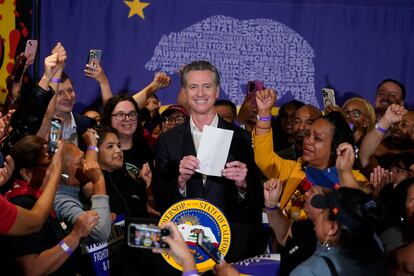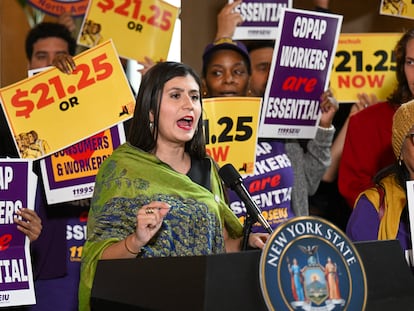California Gov. Gavin Newsom signs law to raise minimum wage for fast food workers to $20 per hour
The state’s minimum wage for all other workers — $15.50 per hour — is already among the highest in the United States

California fast food workers will be paid at least $20 per hour next year under a new law signed Thursday by Democratic Gov. Gavin Newsom.
When it takes effect on April 1, fast food workers in California will have among the highest minimum wages in the country, according to data compiled by the University of California-Berkeley Center for Labor Research and Education. The state’s minimum wage for all other workers — $15.50 per hour — is already among the highest in the United States.
Cheering fast food workers and labor leaders gathered around Newsom as he signed the bill at an event in Los Angeles.
“This is a big deal,” Newsom said.
Newsom’s signature on Thursday reflects the power and influence of labor unions in the nation’s most populous state, which have worked to organize fast food workers in an attempt to improve their wages and working conditions.
It also settles — for now, at least — a fight between labor and business groups over how to regulate the industry. In exchange for higher pay, labor unions have dropped their attempt to make fast food corporations liable for the misdeeds of their independent franchise operators in California, an action that could have upended the business model on which the industry is based. The industry, meanwhile, has agreed to pull a referendum related to worker wages off the 2024 ballot.
“This is for my ancestors. This is for all the farm works, all the cotton-pickers. This is for them. We ride on their shoulders,” said Anneisha Williams, who works at a Jack in the Box restaurant in Southern California.
California’s fast food workers earn an average of $16.60 per hour, or just over $34,000 per year, according to the U.S. Bureau of Labor Statistics. That’s below the California Poverty Measure for a family of four, a statistic calculated by the Public Policy Institute of California and the Stanford Center on Poverty and Equality that accounts for housing costs and publicly-funded benefits.
In California, most fast food workers are over 18 and the main providers for their family, according to Enrique Lopezlira, director of the University of California-Berkeley Labor Center’s Low Wage Work Program.
The $20 minimum wage is just a starting point. The law creates a fast food council that has the power to increase that wage each year through 2029 by 3.5% or the change in averages for the U.S. Consumer Price Index for urban wage earners and clerical workers, whichever is lower.
The raise takes effect on April 1 and applies to workers at restaurants that have at least 60 locations nationwide — with an exception for restaurants that make and sell their own bread, like Panera Bread.
Now, the focus will shift to another group of low-wage California workers waiting for their own minimum wage increase. Lawmakers passed a separate bill earlier this month that would gradually raise the minimum wage for health care workers to $25 per hour over the next decade. That raise wouldn’t apply to doctors and nurses, but to most everyone else who works at hospitals, dialysis clinics or other health care facilities.
But unlike the fast food wage increase — which Newsom helped negotiate — the governor has not said if he would sign the raise for health care workers. The issue is complicated by the state’s Medicaid program, which is the main source of revenue for many hospitals. The Newsom administration has estimated the wage increase would cost the state billions of dollars in increased payments to health care providers.
Labor unions that support the wage increase point to a study from the University of California-Berkeley Labor Center that said the state’s costs would be offset by a reduction in the number of people relying on publicly funded assistance programs.
Sign up for our weekly newsletter to get more English-language news coverage from EL PAÍS USA Edition
Tu suscripción se está usando en otro dispositivo
¿Quieres añadir otro usuario a tu suscripción?
Si continúas leyendo en este dispositivo, no se podrá leer en el otro.
FlechaTu suscripción se está usando en otro dispositivo y solo puedes acceder a EL PAÍS desde un dispositivo a la vez.
Si quieres compartir tu cuenta, cambia tu suscripción a la modalidad Premium, así podrás añadir otro usuario. Cada uno accederá con su propia cuenta de email, lo que os permitirá personalizar vuestra experiencia en EL PAÍS.
¿Tienes una suscripción de empresa? Accede aquí para contratar más cuentas.
En el caso de no saber quién está usando tu cuenta, te recomendamos cambiar tu contraseña aquí.
Si decides continuar compartiendo tu cuenta, este mensaje se mostrará en tu dispositivo y en el de la otra persona que está usando tu cuenta de forma indefinida, afectando a tu experiencia de lectura. Puedes consultar aquí los términos y condiciones de la suscripción digital.
More information
Archived In
Últimas noticias
Most viewed
- Sinaloa Cartel war is taking its toll on Los Chapitos
- Oona Chaplin: ‘I told James Cameron that I was living in a treehouse and starting a permaculture project with a friend’
- Reinhard Genzel, Nobel laureate in physics: ‘One-minute videos will never give you the truth’
- Why the price of coffee has skyrocketed: from Brazilian plantations to specialty coffee houses
- Silver prices are going crazy: This is what’s fueling the rally










































